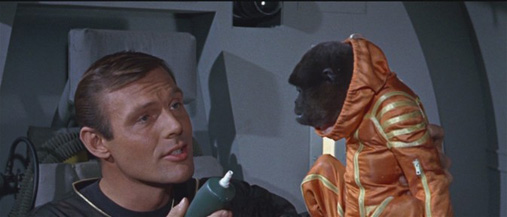Viking Night: Robinson Crusoe on Mars
By Bruce Hall
August 10, 2016
BoxOfficeProphets.com

There’s not really any comparison, obviously. Poor Robinson endures more shenanigans before the end of the first act than ten Matt Damons, and I don’t remember Matt Damon having a monkey with him, which would have made The Martian ten times more awesome. Matt Damon didn’t think to bring a rope, and a pistol, and a book of matches, which obviously you would need on Mars. And Matt Damon wasn’t travelling with Batman. Looks like you lose, Matt Damon.
Okay, I know that sounds like some sort of Freudian fever dream, so let me start over.
Robinson Crusoe on Mars is a seldom-discussed 1964 adventure film wherein two astronauts and yes, a monkey, are stranded on Mars after a near collision in space. Astronaut Christopher Draper (Paul Mantee) and his partner Dan McReady (Adam West) are separated. Draper is able to cobble together enough supplies from his downed ship to set up camp, and heads out to find McReady - only to find that he’s perished. You’ll be glad to know Mona the monkey survives, and joins Team Draper back at base camp.
It’s not clear why there’s a monkey on this mission, and there’s even casual talk of jettisoning the animal into space before the accident. But Mona has her own cute little monkey space suit, and she does (for those who care - because I know you’re out there - yes, I am aware the actual monkey is a he, and yes, I am also aware of how sad that is) adorable things like eat all of Draper’s food and make horrible shrieking sounds. The film does not address what I believe would be the inevitable flinging of poo.
I know this sounds like just the kind of ridiculous movie they used to make back in the days when it was all about giant spiders and fleshy headed invaders in flying saucers. I won’t lie - there’s not a lick of actual science anywhere in this film, but Crusoe nonetheless takes itself relatively seriously. This actually feels like a semi-serious attempt to guess what it might take for an astronaut to survive being stranded on Mars – at a time when nobody really knew much about any of those things. The first half of the movie is essentially The Martian, plus one monkey and minus all the science-y stuff.
Draper ingeniously finds ways to keep himself and Mona alive. Using the wreckage of his ship, he finds ways to generate oxygen, collect water, and harvest food – just like Matt Damon did. Colonel Draper again takes it one step further, building himself a bagpipe and learning to weave clothing out of the local fauna. He even finds time to shave, keep his hair neatly trimmed and keep himself super ripped. It really is a lot of fun watching him gather intel and learn about his surroundings. And it turns out not to be so silly after all, watching him develop an odd but profitable partnership with Mona, who proves pretty good at foraging.
For those keeping count at home, Draper was the one who recommended jettisoning her at the beginning of the movie.
Things get weird a bit more than halfway through when Draper runs into a mysterious traveler (Victor Lundin), confirming that he is not alone on Mars. Draper nicknames the man “Friday,” as a nod to the novel Robinson Crusoe – which for those of you who didn’t pay attention in high school, concerned the exploits of another shipwrecked adventurer. Of course, Friday turns out to have quite a backstory. But the most interesting thing about Robinson Crusoe on Mars isn’t the obvious literary parallel. This was not some creep-of-the-week knockoff, but a supremely inventive film with ambitious goals and rather impressive (for the time) cinematography and special effects.
And while the story itself is clearly meant to be allegorical, a lot of thought seems to have gone into deciding what kinds of equipment and procedures astronauts of the near future might have, and the results are actually pretty effective. This means that legitimate attention is also paid to the fact that after many months of isolation – with no guarantee of rescue – it takes some pretty deep digging to keep yourself off the crazy train.
Another thing this film gets very little love for is the performances. Today, Adam West is the most famous (not to mention only surviving) member of the cast, but as we’ve already discussed, I don’t recommend getting attached to him here. This means that Paul Mantee spends almost the entire first half of the film sharing the screen with just a monkey and the script. To say he sells his role well is an understatement. Vic Lundin has less dialogue here than a Jason Bourne movie (cue Matt Damon reference alert), relying on body language for a large part of his screen time.
And again, it works well. What I guess I’m saying is that not knowing otherwise, you’d expect this to be a really corny, borderline unwatchable film from a laughably backward period in science fiction history. But of course, you’d be wrong. Great sci-fi is by no means a new thing, and I don't consider it hyperbole to call this an overlooked gem of a genre film. Robinson Crusoe on Mars is a really fun, well-acted, extremely watchable classic. It makes you feel like a kid without treating you like one. It's a “B” movie that exceeds its grade in every respect.